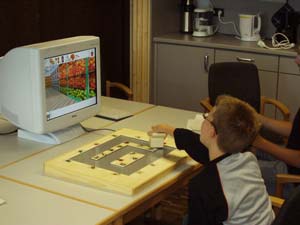Learning Targets:
- By combining the input device and the software environment, children can compare the 2D-plan to the 3D-visuals anytime. This could help to learn methods for understanding other 2D plans like city maps and develop mental models.
- The interaction concept stimulates the users eye-hand-coordination without straining them too much. Smooth fine motor manipulations are rewarded by stunning visuals while bad skills do not detain to play the game.
- The visual design doesn't try to overwhelm children with intellecutal disabilities with too much information. Thus, they can concentrate on comparing needed products from the shopping list to those on the shelves. In this process they are supported by all three abstraction levels: image, symbol and text.
- Training in an artificial supermarket may help children to concentrate on buying the products needed for life and not those being offered in the most effective way. Also the program supports them to buy the right number of items
Testing and Evaluation

The whole system was tested at two schools for children with intellectual disabilities in Hanover, Germany. Around 25 children tried the system of which 22 finished the test successfully.
They had a lot of fun playing and liked the systems very much. Although they hat completely different handicaps and weak points, they all could benefit somehow and mostly in their very subjective way: While some were stunned enough to control the shopping cart and watch the visuals, others thoroughly searched for the products or just liked to look around.
Some counted loudly when they added more of the same products to the cart, others even invented prices which have not yet been included in the software.
Also, for the teachers it was very interesting to see, how the pupils tried to solve the task. Because the input is so direct, you can easily watch people think
and create their own methods to locate the items effectively.
| Go back to... The Input Device | Continue to... Conclusion |
